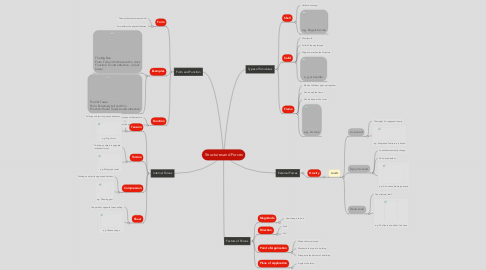
1. Form and Function
1.1. Form
1.1.1. The way that structures are built
1.1.2. Form affects the physical features
1.2. Examples
1.2.1. The Big Ben Form: Tall and Intricate with a clock Function: Tourist attraction, a clock tower
1.2.2. The CN Tower Form: Extremely tall and thin Function: Radio Tower, tourist attraction
1.3. Function
1.3.1. The purpose of the structure
1.3.2. What the structure can do
2. Internal Forces
2.1. Tension
2.1.1. Pulling an object in opposite directions
2.1.2. e.g. Tug of war
2.2. Torsion
2.2.1. Twisting an object in opposite rotational forces
2.2.2. e.g. Wringing a towel
2.3. Compression
2.3.1. Pushing an object in opposite directions
2.3.2. e.g. Chewing gum
2.4. Shear
2.4.1. Two parallel, opposite forces pulling
2.4.2. e.g Cheese strings
3. Types of Structures
3.1. Shell
3.1.1. Hollow but strong
3.1.2. e.g. Rogers Centre
3.2. Solid
3.2.1. Mostly solid
3.2.2. Solid all the way through
3.2.3. Weighs more than shell structure
3.2.4. e.g. A boulder
3.3. Frame
3.3.1. Made of different parts put together
3.3.2. Can be only the frame
3.3.3. Can be frame with a cover
3.3.4. e.g. A crane
4. External Forces
4.1. Gravity
4.1.1. Loads
4.1.1.1. Live Load
4.1.1.1.1. The weight it's supposed to carry
4.1.1.1.2. e.g. People and furniture in a house
4.1.1.2. Dynamic Load
4.1.1.2.1. Loads that constantly change
4.1.1.2.2. Wind and weather
4.1.1.2.3. e.g. A hurricane blowing a house
4.1.1.3. Dead Load
4.1.1.3.1. The structure itself
4.1.1.3.2. e.g. The floors and walls of a house
5. Factors of Forces
5.1. Magnitude
5.1.1. How strong a force is
5.2. Direction
5.2.1. Push
5.2.2. Pull
5.3. Point of Application
5.3.1. Where the force is used
5.3.2. Weakest is the top of a building
5.3.3. Strongest is the bottom of a building
5.4. Plane of Application
5.4.1. Angle of the force

